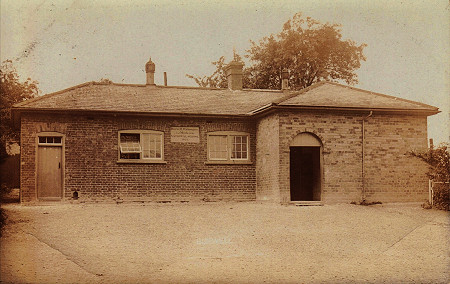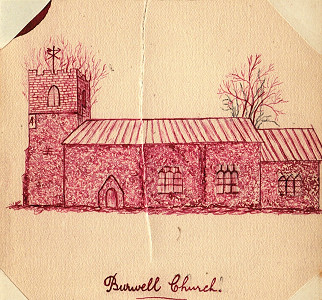Going to school in Burwell in the 1920s

Burwell School

Burwell Church
Peggy Ford wrote about her early childhood in the village of Muckton [“The Girl with Two Names”, 1994]. Because there was no school in Muckton, the children walked to Burwell School:
“Shortly after my fifth birthday, off I went with a small group of children. It was two miles to Burwell, quite a long way for a five-year-old to do twice a day. I would have much preferred to stay at home and play with my toys.
“I soon settled down. It was quite a reasonable little school. We wrote on slates with slate pencils. My, how they squeaked. Miss Higgins, the infant teacher, taught us to spell simple words like cat, bat and rat, also the two, three and four times tables. The thing that gave me the most joy was cutting out objects from coloured paper. We cut out apples, pears, plums and all manner of things. Then there was modelling with grey plasticine. What messy old stuff that was.
“There were only two rooms in the school and two classes. Miss Higgins taught the infants and Miss Emily Smith the big ones. Miss Emily Smith lived with her sister, Miss Edith, in a cottage adjacent to the school playground. Miss Edith had also been a teacher at the school, but by this time was old and ill; at least she seemed old to me, and she was almost certainly dying. When Miss Edith died [in 1926, at the age of 57], all us children had to walk in the funeral procession up the very steep, almost vertical hill to Burwell Church.
“We took potatoes for Miss Higgins to roast on the open fire in the classroom. Otherwise, it was packed sandwiches and a hot meal when we got home at night.
“There was the long walk home. Sometimes we took a cut through Burwell Wood, but not when darkness fell early. Some thought it was a little nearer. That was doubtful, although it may have seemed so as the scenery was different and made a change.
“When we walked by road we took along with us a large hoop made from a narrow rim of iron, and we guided it along with an iron hook. There was quite a knack in this. If we really got it going well, we had to run fast to keep up with it, and that made the journey much quicker.
“In winter when the ground was snow-covered, we took home-made sledges to school, or rather the older children took them, and gave us little ones a ride.
“Mam always wrapped me up well in severe weather. I wore leather gaiters which fastened up the side with what seemed like hundreds of buttons. These had to be fastened with a hook. What a game that was! I well remember her wrapping a huge grey and burgundy striped muffler around me. It was put on over my coat, crossed over my chest and secured at the back with two huge safety pins. On arrival at school, I had to be unpinned by whoever was willing. Over woollen gloves I wore a muff adding extra protection to my hands against the ice-cold winds.”
Burwell School was closed in 1941 with only eleven children on the roll, and it became a garage. The site, west of the main road, almost opposite the church, has now been redeveloped into housing.